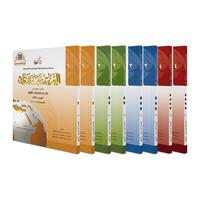٢٫٥٫٥٧ - العلم والتعلم - التعليم بين الماضي والحاضر
2.5.57 – Wissenschaft und Lernen – Bildung zwischen Vergangenheit und Gegenwart
2.5.57 - Science and learning - Education between the past and the present
2.5.57 - Ciencia y aprendizaje - educación entre el pasado y el presente
2.5.57 - Sciences et apprentissage - L'éducation entre passé et présent
2.5.57 - Sains dan pembelajaran - Pendidikan antara masa lalu dan masa kini
2.5.57 - Scienza e apprendimento - L'educazione tra passato e presente
2.5.57 - 科学と学習 - 過去と現在の教育
2.5.57 - Wetenschap en leren - Onderwijs tussen verleden en heden
2.5.57 - Vetenskap och lärande - Utbildning mellan dåtid och nutid
2.5.57 - Bilim ve öğrenme - Geçmiş ile günümüz arasında eğitim
هناك اختلافات كثيرة، بين التعليم في الماضي، والتعليم في الحاضر.
There are many differences between education in the past and education in the present.
Ada banyak perbedaan antara pendidikan di masa lalu dan pendidikan di masa sekarang.
ومن تلك الاختلاف، أن فرص التعليم كانت قليلة في الماضي، حيث كان يلتحق بالمدارس طلاب قليلون، هم - في الغالب - أبناء الأغنياء وسكان المدن.
One of those differences is that educational opportunities were few in the past, when few students attended schools, mostly the children of the rich and city dwellers.
L’une de ces différences réside dans le fait que les possibilités d’éducation étaient rares dans le passé, car peu d’élèves fréquentaient l’école, principalement des enfants de riches et de citadins.
Salah satu perbedaannya adalah bahwa kesempatan pendidikan sangat sedikit di masa lalu, karena hanya sedikit siswa yang bersekolah, dan mereka - kebanyakan - adalah anak orang kaya dan penduduk kota.
أما اليوم، فقد أصبح التعليم حقا لكل مواطن؛ فكثرعدد الطلاب، وانتشرت المدارس في كل مكان، وشاع القول: «التعليم كالماء والهواء».
Today, education has become a right for every citizen; The number of students increased, schools spread everywhere, and the saying became popular: “Education is like water and air.”
Aujourd'hui, l'éducation est devenue un droit pour chaque citoyen. Le nombre d’élèves a augmenté, les écoles se sont répandues partout et le dicton : « L’éducation est comme l’eau et l’air ».
Dewasa ini, pendidikan telah menjadi hak setiap warga negara. Jumlah siswa bertambah, dan sekolah menyebar ke mana-mana, dan pepatah menyebar: "Pendidikan itu seperti air dan udara."
كان الطلاب العلم - في الماضي - يسافرون من بلد إلى بلد؛ لطالب العلم، وكانوا يواجهون في سفرهم كثيرا من التعب؛ فكانوا يركبون الجمال أياما وأشهرا.
Students of science - in the past - traveled from country to country; for the seeker of knowledge, and they used to face a lot of fatigue during their travels; They were riding camels for days and months.
Autrefois, les étudiants voyageaient de pays en pays. Pour ceux qui recherchent la connaissance, ils font face à beaucoup de fatigue lors de leur voyage. Ils montaient à dos de chameau pendant des jours et des mois.
أما اليوم، فالمدارس والجامعات كثيرة، في كل مدينة وقرية تقريبا، حيث يذهب الطالب إلى مدرسته، أو جامعته بالسيارة، أو سيرا على الأقدام.
Today, there are many schools and universities, in almost every city and village, where the student goes to his school or university by car or on foot.
Aujourd'hui, il existe de nombreuses écoles et universités, dans presque toutes les villes et villages, où l'étudiant se rend à son école ou université en voiture ou à pied.
Saat ini terdapat banyak sekolah dan universitas, di hampir setiap kota dan desa, dimana siswa pergi ke sekolah atau universitasnya dengan mobil atau berjalan kaki.
ومن ناحية أخرى، يستطيع الطالب أن يتعلم، وهو في بيته عن طريق الشبكة الدولية.
On the other hand, the student can learn at home through the international network.
En revanche, l'étudiant peut apprendre depuis son domicile via le réseau international.
Di sisi lain, siswa dapat belajar selama di rumah melalui jaringan internasional.
من الاختلافات أيضا.
There are also differences.
Des différences aussi.
dari perbedaan juga.
أن المعلم كان لا يطلب أجرا على عمله في الماضي؛ لأنه كان يطلب الأجر من الله.
that the teacher did not ask for a wage for his work in the past; Because he was asking for reward from God.
Que l’enseignant n’a pas demandé de rémunération pour son travail dans le passé ; Parce qu'il demandait une récompense à Dieu.
bahwa guru itu tidak meminta upah atas pekerjaannya di masa lalu; Karena dia mencari pahala dari Tuhan.
وكان هدف الطلب طلب العلم.
The purpose of the request was to seek knowledge.
Le but de la demande était de rechercher des connaissances.
Tujuan dari permintaan itu adalah untuk mencari ilmu.
أما اليوم فقد اختلف الأمر، فالمعلم يطلب كثيرا من الأجر، والطالب يفكر في الشهادة قبل العلم؛ لأنها وسيلة إلى العمل.
Today, however, the matter is different. The teacher asks for a lot of wages, and the student thinks of martyrdom before knowledge. Because it is a way to work.
Aujourd'hui, la situation est différente : l'enseignant exige beaucoup de récompenses et l'élève pense à la certification avant de connaître. Parce que c'est une façon de travailler.

